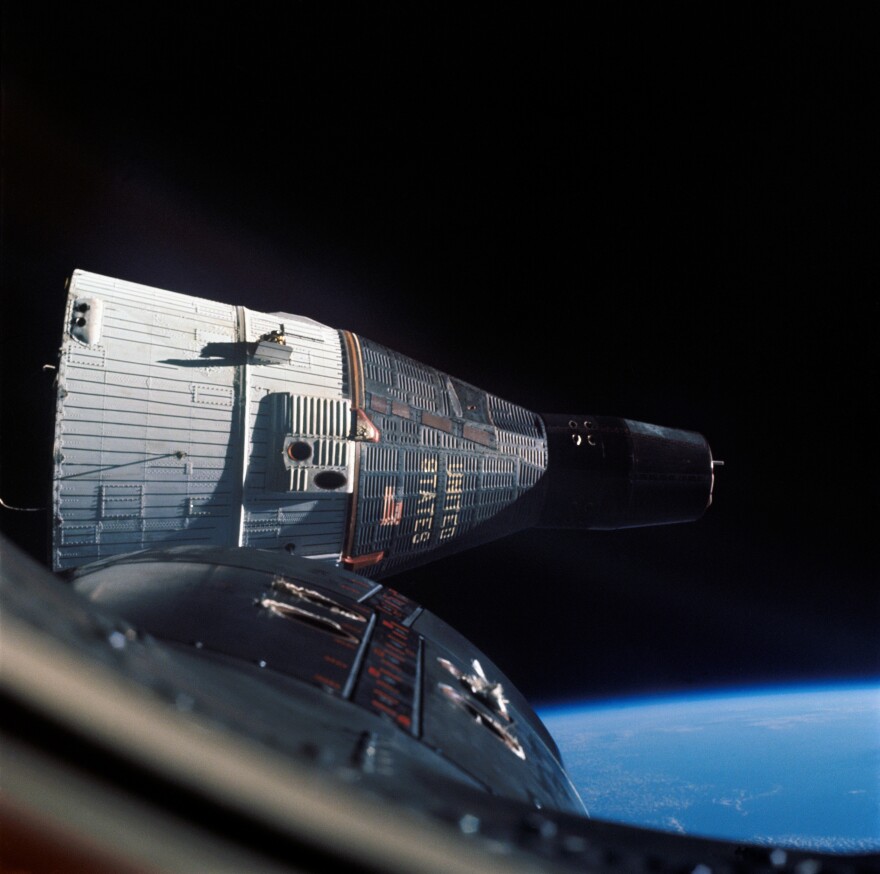It's an elite club, traveling to the moon. And four members of that exclusive group gathered in Oklahoma on Wednesday to celebrate 50 years since they completed an earlier mission critical to the eventual success of landing humans on the lunar surface.
On December 15, 1965, Weatherford native Thomas Stafford and the late Wally Schirra, one of the original Mercury 7 astronauts, launched from the Kennedy Space Center in a capsule about the size of a Volkswagen Beetle. Their mission, Gemini 6A, would meet up in space with Gemini 7. That craft, piloted by astronauts Frank Borman and Jim Lovell, had already been in low-Earth orbit for 11 days.
Stafford led a panel discussion Wednesday afternoon at the Oklahoma History Center, and reminisced with fellow Gemini and Apollo astronauts Lovell, Buzz Aldrin, and Alan Bean, along with Glynn Lunney, a NASA flight director during the Gemini and Apollo programs.
That in-orbit rendezvous between 6A and 7 was the first time two manned spacecrafts had met in space, and was critical to the future Apollo lunar missions. Astronauts had to prove they could successfully dock with another spacecraft in orbit, so they could later connect the lunar landing vehicle with the crew module for the trip to and from the moon.
"Deke Slayton, the director of flight crew operations, came in and said, 'You guys, look, the monkey is really on your back'," Stafford said. "This whole program, this national program, you've got 400,000 people working on it, is based on doing that lunar orbit rendezvous. And you've got to be sure you're successful.'"

Lunney said the idea of lunar orbit rendezvous came out of necessity. Building the entire Apollo spacecraft in pieces, most of which would be left behind in space, allowed engineers to use less fuel and material like a heat shield - which would protect the astronauts during the fiery atmospheric reentry to Earth. Lunney said landing everything on the moon would be like a taking a commercial jet carrying 100 people down the street. Using the lunar module as what he described as a taxi cab allowed astronauts to leave the biggest, heaviest, "come-home stuff" in lunar orbit.
"NASA bet a lot on the rendezvous techniques," Lunney said. "The Gemini program was an indication that we were gong to bet on the rendezvous technique that made it doable in the schedule - time and money - that we had."
Most of the Gemini missions involved making that rendezvous with an unmanned target vehicle called Agena. Gemini 6, with Stafford and Schirra, was supposed to launch in October 1965. Shortly before liftoff of the manned portion, Mission Control in Houston lost contact with the rocket carrying the Agena. The original mission was scrapped, and re-designated Gemini 6A with a launch date in mid-December.
Stafford and Schirra's new objective included an in-orbit rendezvous with Gemini 7. Borman and Lovell had already been in space for nearly two weeks as part of a study of the long-term effects of spaceflight on the human body.

The two spacecrafts met in orbit, and at one point were only about one foot apart. There was even talk of an extra-vehicular activity that would've involved both Stafford and Lovell exiting the Gemini capsules, and essentially trading places.
"That sounded like a pretty good idea, except because we had been delayed, better minds got hold of us and said, 'Listen, let's not jam too much on this [mission].'," Lovell said. "We're already substituting Gemini 7 for the Agena rocket that didn't make it to space, so let's just see if we can rendezvous. That's the major thing that we have to do. And that's what happened. We scrubbed the so-called EVA."
Stafford said even today, the techniques they perfected during the Gemini program help astronauts survive in space and carry out their missions aboard the International Space Station.
"We've had so many flights to the space station. The space station has been built up by rendezvous," Stafford said. And the Russians' process for supplies have rendezvoused over 60 times. With the crew...they've had at least 41 or 42 rendezvous. That includes the last part of our shuttle and the Soyuz. It's a continuation of the rendezvous that's based on what we did."
KGOU is a community-supported news organization and relies on contributions from readers and listeners to fulfill its mission of public service to Oklahoma and beyond. Donate online, or by contacting our Membership department.















